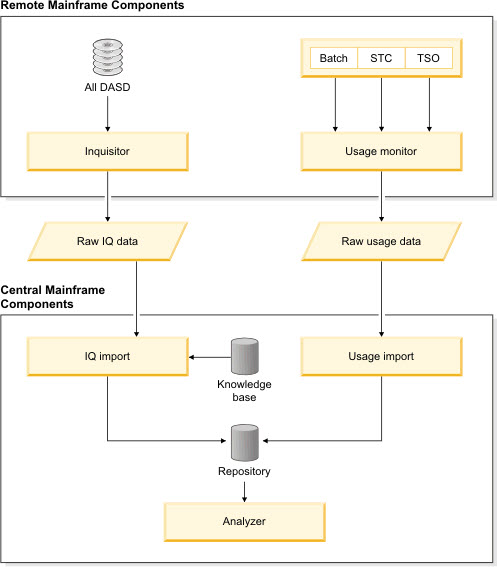Overview of HCL ZAO V2.1.1
HCL ZAO V2.1.1 collects raw data on products and their usage on the mainframe, and then downloads collected raw data to a website, subsequently this data is uploaded to containers for further processing.
The processed data can be viewed via reports as follows:
- Discover and identify products for the z/OS platform.
- Monitor software usage and trends.
- Provide reporting for assets and usage.
The benefits of using this software are:
- Used and unused software are identified.
- Users of software are identified.
- Obsolete versions of software are identified, and the usage of these versions determined.
- Usage trends of software and libraries are identified.
In a z/OS environment software is contained in load libraries or as z/OS UNIX executable files. HCL ZAO V2.1.1 scans contents of these libraries and executable files to determine which software products are installed. HCL ZAO V2.1.1 also monitors the loaded programs and executable files to measure software usage.
The discovered load libraries and executable files are then checked against a global database of product information. HCL ZAO V2.1.1 uses this information to determine which products are installed and used on each system.
The HCL ZAO V2.1.1 Usage Monitor gathers information about events for modules and executable files which are then attributed to each product.
The workflow is illustrated in Figure 1, followed by a brief description of the components.

| Components | Description |
|---|---|
|
Inquisitor |
The Inquisitor is a batch job (HZACINQZ and HZACINQU) that discovers loadable programs in z/OS data sets and z/OS UNIX System Services file systems. A program locates load libraries on z/OS DASD devices and captures information about the load modules. The process can be targeted to specific devices, libraries, or groups of libraries. The program creates a compressed data set, which is then used as input to the Inquisitor Import procedure. An additional process locates and scans z/OS UNIX directories for program objects and captures this information. The process creates a compressed data set that is then used as input to the Inquisitor Import for z/OS UNIX procedure. |
| Usage Monitor | The Usage Monitor is a started task or batch job (HAZCUMON) that monitors, and records loaded modules of batch jobs, started tasks, TSO users, and z/OS UNIX executable files. |
| Knowledge Base |
The Global Knowledge Base (GKB) is a database that is provided with HCL ZAO V2.1.1. The GKB has a list of all z/OS globally identified products that are used by the product in the process of matching. |
| Inquisitor (IQ) Import |
The Inquisitor Import is a task that matches Inquisitor data consisting of z/SO load modules and UNIX program objects, against the Global Knowledge Base. The Inquisitor data is then imported into the Repository. |
| Usage Import |
The Usage Monitor is a task that imports Usage Monitor data into the Repository. The data is matched against load modules and z/OS UNIX executable files and the data is then aggregated with installed software products. After this process has been completed, you can view the usage data using the reporting tool. |
| Repository |
The Repository is a set of database tables that stores information about the software products discovered and their usage data. |
| Reporting |
The reporting tool queries the Repository database and displays online reports. |
Process flow
Data is collected on the z/OS systems by the Inquisitor and the Usage Monitor batch programs. You can then import this data into the Repository database and review reports produced by the ZAO analysis engine.
Following is a summary of the workflow tasks:
- Configure, run and optionally automate, z/OS Inquisitor and usagedata collectors.
- Download zip compressed z/OS Inquisitor and usage data filesto workstation/desktop.
- Upload zip compressed z/OS Inquisitor and usage data files to the Linux on Z ZAO UI docker container.
- Import Asset data collected by the Inquisitor into the Repository.
- Import the collected usage data into the Repository.
- Optionally run utilities to manage and maintain your repository data.
- View analysis reports using repository data available through the ZAO UI web-based online reporting tool.